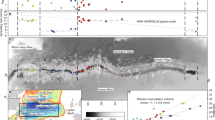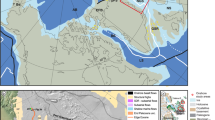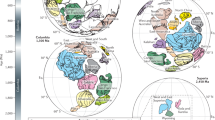Abstract
On the Beagle voyage, Charles Darwin first noted the creation and subsidence of ocean islands1, establishing in geology’s infancy that island freeboard changes with time. Hotspot ocean islands have an obvious mechanism for freeboard change through the growth of the bathymetric anomaly, or swell2, on which the islands rest. Models for swell development indicate that flexural9, thermal2,3 or dynamic pressure4,5,6,8 contributions, as well as spreading of melt residue from the hotspot7, can all contribute to island uplift. Here we test various models for swell development using the uplift histories for the islands of the Cape Verde hotspot, derived from isotopic dating of marine terraces and subaerial to submarine lava-flow morphologies. The island uplift histories, in conjunction with inter-island spacing, uplift rate and timing differences, rule out flexural, thermal or dynamic pressure contributions. We also find that uplift cannot be reconciled with models that advocate the spreading of melt residue in swell development unless swell growth is episodic. Instead, we infer from the uplift histories that two processes have acted to raise the islands during the past 6 Myr. During an initial phase, mantle processes acted to build the swell. Subsequently, magmatic intrusions at the island edifice caused 350 m of local uplift at the scale of individual islands. Finally, swell-wide uplift contributed a further 100 m of surface rise.
This is a preview of subscription content, access via your institution
Access options
Subscribe to this journal
Receive 12 print issues and online access
$259.00 per year
only $21.58 per issue
Buy this article
- Purchase on Springer Link
- Instant access to full article PDF
Prices may be subject to local taxes which are calculated during checkout



Similar content being viewed by others
References
Darwin, C. R. The Structure and Distribution of Coral Reefs (Smith Elder, 1842).
Crough, S. T. Thermal origin of mid-plate hot-spot swells. Geophys. J. R. Astron. Soc. 55, 451–469 (1978).
Detrick, R. S. & Crough, S. T. Island subsidence, hot spots and lithospheric thinning. J. Geophys. Res. 83, 1236–1244 (1978).
Davies, G. F. Ocean bathymetry and mantle convection 1. Large-scale flow and hotspots. J. Geophys. Res. 93, 10467–10480 (1988).
Olson, P. in Magma Transport and Storage (ed. Ryan, M. P.) 33–51 (John Wiley, 1990).
Sleep, N. H. Hotspots and mantle plumes: Some phenomenology. J. Geophys. Res. 95, 6715–6736 (1990).
Morgan, J. P., Morgan, W. J. & Price, E. Hotspot melting generates both hotspot volcanism and a hotspot swell? J. Geophys. Res. 100, 8045–8062 (1995).
Ribe, N. M. & Christensen, U. R. The dynamical origin of Hawaiian volcanism. Earth Planet. Sci. Lett. 171, 517–531 (1999).
Grigg, R. & Jones, A. Uplift caused by lithospheric flexure in the Hawaiian Archipelago as revealed by elevated coral deposits. Mar. Geol. 141, 11–25 (1997).
Robinson, E. M. The topographic and gravitational expression of density anomalies due to melt extraction in the uppermost oceanic mantle. Earth Planet. Sci. Lett. 90, 221–228 (1988).
Ramalho, R., Helffrich, G., Schmidt, D. N. & Vance, D. Tracers of uplift and subsidence in the Cape Verde Archipelago. J. Geol. Soc. Lond. 167, 519–538 (2010).
Ali, M., Watts, A. & Hill, I. A seismic reflection profile study of lithospheric flexure in the vicinity of the Cape Verde Islands. J. Geophys. Res. 108, 2239 (2003).
Huppert, H. E. The propagation of two-dimensional and axisymmetric viscous gravity currents over a rigid horizontal surface. J. Fluid Mech. 121, 43–58 (1982).
Lodge, A. & Helffrich, G. Depleted swell root beneath the Cape Verde Islands. Geology 34, 449–452 (2006).
Pim, J., Watts, A. B., Grevemeyer, I. & Krabbenhoeft, A. Crustal structure and origin of the Cape Verde Rise. Earth Planet. Sci. Lett. 272, 422–428 (2008).
Crough, S. T. Geoid height anomalies over the Cape Verde rise. Mar. Geophys. Res. 5, 263–271 (1982).
McNutt, M. Thermal and mechanical properties of the Cape Verde rise. J. Geophys. Res. 93, 2784–2794 (1988).
Monnereau, M. & Cazenave, A. Depth and geoid anomalies over oceanic hotspot swells: A global survey. J. Geophys. Res. 95, 15429–15438 (1990).
Faugères, J. C., Legigan, P., Maillet, N. & Latouche, C. in Proc. Ocean Drilling Prog., Sci. Rep. Vol. 108 (eds Ruddiman, W. et al.) 311–327 (Ocean Drilling Program, 1989).
Torres, P. C. et al. Geologia da Ilha do Sal. Com. Inst. Inv. Cient. Tropical 10 (2002).
McNutt, M. & Menard, H. W. Lithospheric flexure and uplifted atolls. J. Geophys. Res. 83, 1206–1212 (1978).
Smith, J. R. & Wessel, P. Isostatic consequences of giant landslides on the Hawaiian ridge. PAGEOPH 157, 1097–1114 (2000).
Pollard, D. D. & Johnson, A. M. Mechanics of growth of some laccolithic intrusions in the Henry Mountains, Utah, II. Tectonophysics 18, 311–354 (1973).
Kavanagh, J. L., Menand, T. & Sparks, R. S. J. An experimental investigation of sill formation and propagation in layered elastic media. Earth Planet. Sci. Lett. 245, 799–813 (2006).
Tamura, Y., Tatsumi, Y., Zhao, D., Kido, Y. & Shukuno, H. Hot fingers in the mantle wedge: New insights into magma genesis in subduction zones. Earth Planet. Sci. Lett. 197, 105–116 (2002).
Stillman, C. J., Furnes, H., LeBas, M. J., Robertson, A. H. F. & Zielonka, J. The geological history of Maio, Cape Verde Islands. J. Geol. Soc. Lond. 139, 347–361 (1982).
Morgan, W. J. in Studies in Earth and Space Sciences, A Volume in Honor of Harry Hammond Hess (eds Shagam, et al.) 7–22 (Memoir, Vol. 132, Geological Society of America, 1972).
Miller, K. et al. The Phanerozoic record of global sea level change. Science 310, 1293–1298 (2005).
Acknowledgements
We acknowledge the Fundação para a Ciência e para a Tecnologia (FCT) for support for R.R.’s PhD scholarship SFRH/BD/24835/2005, co-financed by POPH/FSE, and the Royal Society University Research Fellowship supporting D.N.S. We thank our colleagues in Lisbon, A. Serralheiro, C. Silva, J. Madeira and A. Silveira, for their constant support, S. Kaneshima for discussions and B. Faria and E. Harms for their enthusiastic support in Cape Verde. We also thank E. Takahashi for insight into volcanic basement uplift and salute the original reviewers’ insistence on identifying a viable process for local uplift.
Author information
Authors and Affiliations
Contributions
R.R. undertook all field work, dated samples and interpreted results, G.H. designed the project, participated in field work and interpreted results, M.C. supervised Ar–Ar analyses and provided laboratory facilities, D.V. supervised Sr analyses and provided laboratory facilities, D.H. did U–Th analyses and D.N.S. participated in field work and provided palaeodepths from fossil assemblages.
Corresponding authors
Ethics declarations
Competing interests
The authors declare no competing financial interests.
Supplementary information
Supplementary Information
Supplementary Information (PDF 267 kb)
Rights and permissions
About this article
Cite this article
Ramalho, R., Helffrich, G., Cosca, M. et al. Episodic swell growth inferred from variable uplift of the Cape Verde hotspot islands. Nature Geosci 3, 774–777 (2010). https://doi.org/10.1038/ngeo982
Received:
Accepted:
Published:
Issue Date:
DOI: https://doi.org/10.1038/ngeo982
This article is cited by
-
Integrated Geochemical and Mineralogical Investigation of Soil from the Volcanic Fogo Island (Cape Verde): Implications for Ecological and Probabilistic Human Health Risks
Exposure and Health (2023)
-
Internal igneous growth, doming and rapid erosion of a mature ocean island: the Miocene evolution of Maio (Cabo Verde)
International Journal of Earth Sciences (2022)
-
The evolution of Santa Maria Island in the context of the Azores Triple Junction
Bulletin of Volcanology (2020)
-
Application of Time-Domain Electromagnetic Method in Investigating Saltwater Intrusion of Santiago Island (Cape Verde)
Pure and Applied Geophysics (2017)
-
Fractional crystallization of Si-undersaturated alkaline magmas leading to unmixing of carbonatites on Brava Island (Cape Verde) and a general model of carbonatite genesis in alkaline magma suites
Contributions to Mineralogy and Petrology (2016)



